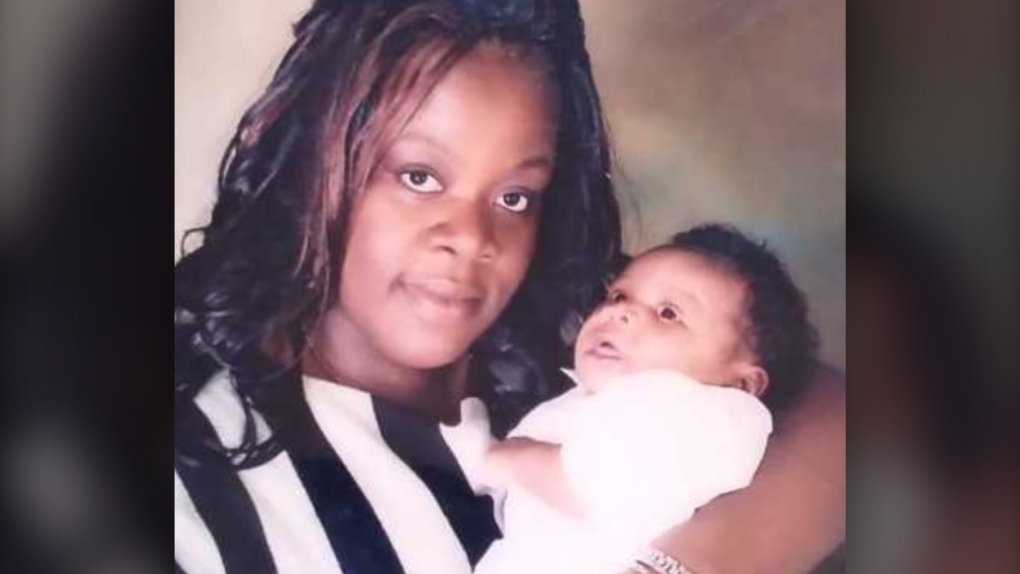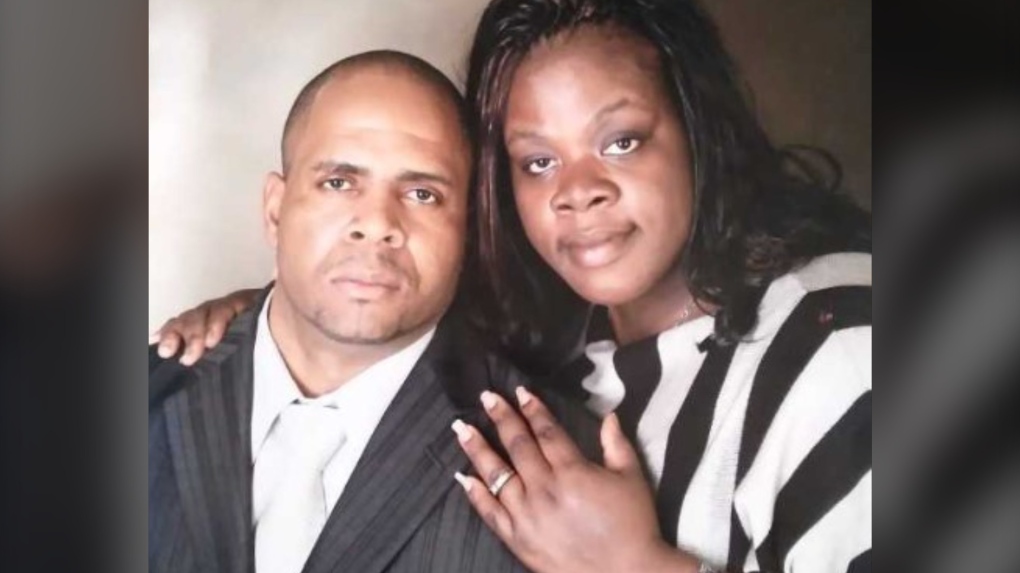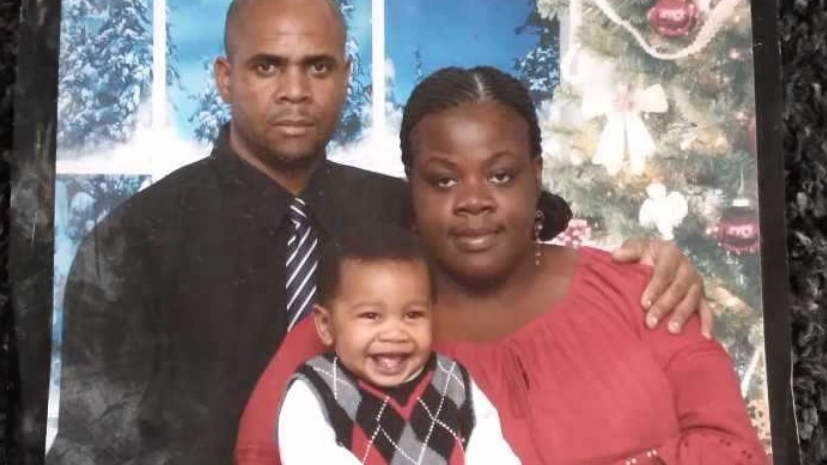Toronto father of 4 wins years-long lawsuit against GTA doctor ruled to have caused wife's 'untimely' death
A Toronto area doctor has been found liable for the “untimely” death of a 34-year-old mother who showed up at a Brampton emergency room complaining of severe pain, but was discharged before a tangle in her lower intestines could be discovered.
Elisha Shaw checked into the emergency department at Brampton Civic Hospital late in the evening of Nov. 16, 2015.
- Download our app to get local alerts on your device
- Get the latest local updates right to your inbox
She was complaining of severe abdominal pain at the time. The emergency physician ordered a number of tests, including a CT scan, but Shaw was ultimately discharged from the hospital less than 12 hours later with instructions to obtain an appointment with her bariatric surgeon and a prescription for abdominal cramps.
Shaw died two weeks later, at Humber River Hospital, on Nov. 25, 2015.
In an Ontario Superior Court of Justice decision published last week, Justice (JP) William Lemay found the death of Shaw could be pinpointed to the decision to discharge her before it was found she had an internal hernia – despite her exhibiting, at times, “unmanageable” pain.
Shaw’s former husband Merton Thompson and their four children, listed as co-plaintiffs in the suit, were awarded at least $493,000 in damages plus additional damages for loss of income and household contributions, which are still to be determined by the court.
When reached for comment on the decision, William Osler Health System, which oversees Brampton Civic, extended its “sincere condolences for the families’ loss,” but out of “respect for confidentiality and privacy,” said it could not provide further statement.
“If you knew Elisha, you got along with her,” Thompson told CTV News Toronto. “She was a very nice person, very easy to be with.”
 Elisha Shaw can be seen above. (Handout by Cahill and Thompson)
Elisha Shaw can be seen above. (Handout by Cahill and Thompson)
AN ‘UNTIMELY DEATH’
In 2012, Shaw had undergone a gastric bypass at the advice of her doctors. The procedure, a type of bariatric surgery, is designed to reduce the size of the stomach. It results in the patient having fewer intestines which can cause them, “in layman terms,” Lemay wrote, “to move around and become tangled.”
After checking into Brampton Civic, Shaw was seen by Dr. Jeffery Handler just after midnight on Nov. 16.
Handler, an emergency physician who currently holds hospital privileges at William Osler Health System, ordered blood tests, along with a CT scan, as he was concerned of the possibility of a bowel obstruction. At about 4 a.m., the ruling states Handler discussed the CT results with Shaw and Thompson, informing the couple he observed no obstruction. Shaw’s pain had not diminished by this time, the ruling states, and she was soon found to have been “crying aloud with pain.”
Nursing staff described Shaw as “unmanageable” and Thompson as “demanding more medication for her” in their notes. On the contrary, Handler testified that Shaw’s pain had decreased by the time she was dismissed, claiming he noted so in the emergency records. Nursing staff said there was no indication of any change in Shaw’s pain in their notes.
Ultimately, Handler dismissed Shaw with instructions to obtain an appointment with her bariatric surgeon and a prescription for abdominal cramps at about 7 a.m. on Nov. 17.
"[Our] concerns never meant nothing to nobody at the hospital," Thompson said.
It was around the time that Shaw and Thompson were leaving that a second review of the woman’s CT scan – this time, by a radiologist – revealed that she was suffering from an internal hernia. The radiologist communicated those results to Dr. Handler, but it was too late – Shaw had been discharged – and the doctor failed to follow-up with those results, the ruling found.
“It was at that precise moment where the court found the mistake happened,” civil litigator Paul Cahill, who represented the Thompson family for the seven years since Shaw’s death, said. “What he should have done was called Elisha back, [and] they could have done a surgery that day that might have saved her life.”
Shaw and Thompson returned home, but it wasn’t long until she’d be forced back to hospital – the next morning, her pain required her to call an ambulance, the ruling reads.
Shaw was taken again to Brampton Civic Hospital and was soon sent into surgery where it was found she was suffering from an internal hernia, the ruling reads. The diagnosis came nearly two days after Shaw initially reported to the emergency department.
Despite the emergency surgery, by the next morning, Shaw’s health had deteriorated, the document reads. A “significant” part of her small bowel had developed necrosis, or begun to die. It would have to be removed.
Shaw was then transferred to Humber River Regional Hospital where she underwent a second surgery, but the necrosis continued to spread and despite further treatment, died on Nov. 25.
 Merton Thompson can be seen alongside Elisha Shaw above. (Handout by Paul Cahill and Merton Thompson)
Merton Thompson can be seen alongside Elisha Shaw above. (Handout by Paul Cahill and Merton Thompson)
Had Shaw's hernia been discovered when she reported to Brampton Civic's emergency department, Thompson believes she could have received lifesaving care, a sentiment endorsed by the JP’s decision.
“I have determined that Dr. Handler’s care of Ms. Shaw fell below the standard of care required of an emergency room physician and was negligent," Lemay wrote.
"I have also concluded that Dr. Handler’s negligence caused Ms. Shaw’s death, as surgical intervention on Nov. 17 would have resulted in a much better outcome."
Lawyers representing Handler did not respond to requests for comment. Within proceedings, the physician disputed the assertion that had Shaw’s hernia been discovered, she could have undergone successful surgery that night, Lemay noted in the decision.
‘MORE THAN CHALLENGING’
In the wake of his wife’s death, Thompson was left to navigate his grief while caring for four children ranging from just over one to seven years old.
“He worked nights at Walmart so that, during the day, he could take care of his children,” Cahill said.
"For years, he’d come home from work and get them ready for school, then he’d sleep a bit while they're at school or in daycare, pick them up again and take care of them, and then once they got to bed, he’d go back off to work.”
Thompson said life since Shaw’s death has been “more than challenging.”
“But I had to work to keep food on the table for my family,” he said.
 Merton Thompson and Elisha Shaw can be seen above. (Handout by Cahill and Thompson)
Merton Thompson and Elisha Shaw can be seen above. (Handout by Cahill and Thompson)
DIFFICULT CASES TO PROVE: EXPERTS
Twenty-eight thousand people lose their lives due to harm suffered in the Canadian healthcare system every year – it’s the third leading cause of death in the country, behind cancer and heart disease – yet, medical malpractice and/or negligence lawsuits, like Thompson’s, are rare, and successful cases, even rarer, experts say.
According to a survey published last year by Healthcare Excellence Canada, "about one in 10 adults say that a medical mistake was made in their own or loved ones' treatment or care over the last few years," CEO Jennifer Zelmer told CTV News Toronto.
"The most common things that people reported are misdiagnoses, wrong medications, missed symptoms, lack of follow up or care after a procedure, and delayed treatments."
But lawsuits that find those mistakes liable are less common, according to Cahill.
“These cases are really complicated and difficult to prove,” Cahill said. “And it’s a challenge in order for a plaintiff to be successful.”
Expert witness testimony is required in medical malpractice or negligence, which can be one of the barriers, the lawyer explained.
“We have to get doctors willing to participate in the process and be critical of other doctors and that can be a big challenge,” he said.
In Thompson’s case, Lemay heard expert testimony from two radiologists, two surgeons, two emergency medicine specialists, an accountant, and an economist.
The civil litigation process, while often challenging, can be also used as an avenue to build safer practices and reduce harm, Zelmer said.
“The ability to feel safe speaking up, to raise concerns and then see those concerns followed through on is a critical component of not just addressing past harm, but also really contributing to a positive presence of safety," she said.
"Because of course, while it's critical to learn from past harm, we also want to be creating an environment where we're delivering safer care going forward."
CTVNews.ca Top Stories

BREAKING Boissonnault out of cabinet to 'focus on clearing the allegations made against him,' Trudeau announces
Prime Minister Justin Trudeau has announced embattled minister Randy Boissonnault is out of cabinet.
Families of Paul Bernardo's victims not allowed to attend parole hearing in person, lawyer says
The families of the victims of Paul Bernardo have been barred from attending the serial killer’s upcoming parole hearing in person, according to the lawyer representing the loved ones of Kristen French and Leslie Mahaffy.
Baby dies after being reported missing in midtown Toronto: police
A four-month-old baby is dead after what Toronto police are calling a 'suspicious incident' at a Midtown apartment building on Wednesday afternoon.
'They squandered 10 years of opportunity': Canada Post strike exposes longtime problems, expert says
Canada Post is at ‘death's door’ and won't survive if it doesn't dramatically transform its business, a professor who has studied the Crown corporation is warning as the postal workers' national strike drags on.
Sask. woman who refused to provide breath sample did not break the law, court finds
A Saskatchewan woman who refused to provide a breath sample after being stopped by police in Regina did not break the law – as the officer's request was deemed not lawful given the circumstances.
'Bomb cyclone' batters B.C. coast with hurricane-force winds, downing trees onto roads and vehicles
Massive trees toppled onto roads, power lines and parked cars as hurricane-force winds battered the B.C. coast overnight during an intense “bomb cyclone” weather event.
Ford says there is 'clear consensus' among premiers for separate trade deal with Mexico
Ontario Premier Doug Ford says there is 'clear consensus' among premiers for separate bilateral trade deals with the U.S. and Mexico, following a phone call with all the leaders on Wednesday.
EV battery manufacturer Northvolt faces major roadblocks
Swedish electric vehicle battery manufacturer Northvolt is fighting for its survival as Canadian taxpayer money and pension fund investments hang in the balance.
Canada closes embassy in Ukraine after U.S. receives information on 'potential significant air attack'
The Embassy of Canada to Ukraine, located in Kyiv, has temporarily suspended in-person services after U.S. officials there warned they'd received information about a 'potential significant air attack,' cautioning citizens to shelter in place if they hear an air alert.
































